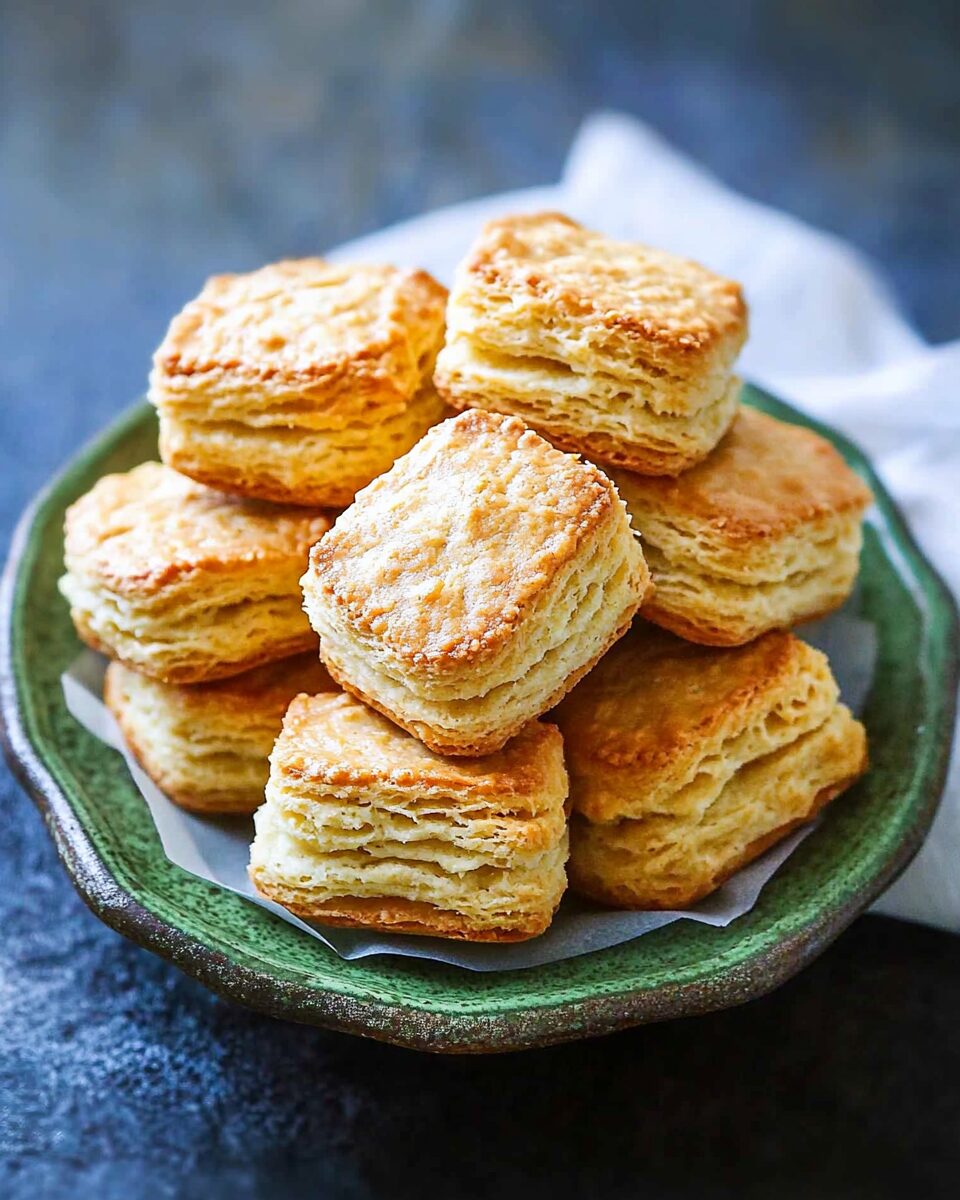These Irish Buttermilk Biscuits are the perfect combination of rustic charm and delicate texture. With a beautifully golden crust and tender, flaky interior, they’re a testament to the simple brilliance of traditional baking. The use of cold butter ensures that each bite delivers a buttery richness, while buttermilk provides a slight tang that balances the flavor perfectly. Ideal for serving at breakfast or brunch, these biscuits can also accompany hearty stews or be enjoyed with a dollop of jam for afternoon tea.
This recipe is inspired by generations of Irish home bakers who embraced resourcefulness and simplicity. With only a handful of pantry staples, these biscuits prove that the best recipes don’t need to be complicated. Whether you’re making them for a festive St. Patrick’s Day meal or just craving something warm and comforting, these Irish biscuits will win over hearts with their flaky layers and nostalgic taste.
Full Recipe
Ingredients:
-
2 cups all-purpose flour
-
1 tablespoon baking powder
-
½ teaspoon baking soda
-
1 teaspoon salt
-
6 tablespoons unsalted butter, cold and cubed
-
¾ cup buttermilk
Directions:
-
Preheat your oven to 450°F (232°C) and line a baking sheet with parchment paper.
-
In a large mixing bowl, whisk together the flour, baking powder, baking soda, and salt.
-
Add the cold, cubed butter to the dry ingredients and use a pastry cutter or your fingers to incorporate until the mixture resembles coarse crumbs.
-
Make a well in the center and pour in the buttermilk. Stir just until combined—do not overmix.
-
Turn the dough out onto a lightly floured surface. Gently knead and fold a few times to create layers, then pat into a 1-inch thick rectangle.
-
Use a biscuit cutter to cut out biscuits and place them onto the prepared baking sheet.
-
Bake for 12–15 minutes, or until the tops are golden brown. Serve warm with butter, jam, or honey.
Prep Time: 10 minutes | Cooking Time: 15 minutes | Total Time: 25 minutes
Kcal: 180 kcal per biscuit | Servings: 8 biscuits
The Charm and History of Irish Biscuits
Irish biscuits hold a cherished place in traditional Irish baking and culture. They are not to be confused with the sweet cookies often referred to as “biscuits” in the UK. Instead, these are more akin to the American-style flaky, buttery breakfast biscuits—soft on the inside, lightly crisp on the outside, and incredibly comforting. They embody the simplicity and warmth of Irish home cooking, often served with butter, jam, or honey, and sometimes used to accompany stews or soups.
What sets Irish biscuits apart is their heritage. Rooted in rustic kitchens where ingredients were humble but prepared with care, these biscuits reflect the Irish values of resourcefulness and hospitality. Passed down through generations, this recipe remains beloved not only for its flavor but also for the nostalgic feelings it evokes.
Why These Biscuits Are So Loved
There’s a reason why Irish buttermilk biscuits continue to be baked in homes across Ireland and beyond. They require only a few pantry staples—flour, baking powder, salt, butter, and buttermilk—yet deliver incredible results. The key lies in the technique: cutting cold butter into the flour and using buttermilk for tenderness and rise. These steps yield a dough that bakes into fluffy, flaky layers that peel apart beautifully when warm.
Irish biscuits are adaptable too. They can be served sweet or savory, making them a versatile addition to any meal. Spread with jam at breakfast, topped with honey for tea time, or paired with a hearty bowl of Irish stew, they seamlessly fit into every occasion. Their mild, buttery flavor makes them an excellent canvas for whatever toppings or additions you prefer.
The Role of Buttermilk in the Recipe
Buttermilk is the secret star of this recipe. Its acidity reacts with the baking soda to help the biscuits rise and contributes a subtle tang that deepens the overall flavor. It also helps tenderize the dough, resulting in a light, moist texture. For generations, buttermilk was a staple in rural Irish kitchens, often a byproduct of butter churning. Its use in baking wasn’t just about flavor—it was a way of making the most out of what was on hand.
In modern kitchens, buttermilk still holds its magic. Even if you don’t have traditional buttermilk, a quick mix of milk and lemon juice or vinegar can replicate its qualities. This humble ingredient connects past and present, continuing to lend that signature Irish flavor and texture to the biscuits.
Tips for Getting the Perfect Biscuit Texture
Getting the texture just right is crucial for the success of Irish biscuits. The butter should be cold—this allows it to melt slowly in the oven, creating steam pockets that lead to those beautiful, flaky layers. Overmixing the dough is a common mistake; it can activate too much gluten, resulting in tough biscuits. Gentle handling is key.
Another tip: fold the dough a few times before cutting. This process creates additional layers and mimics the effect of laminated doughs like croissants, but with much less effort. The final height and fluffiness will depend on the thickness of your dough before cutting, so don’t roll it too thin—about 1 inch is ideal.
Serving Ideas and Pairings
There’s no wrong way to enjoy these biscuits. They’re incredibly versatile and pair beautifully with both sweet and savory toppings. Here are a few popular serving suggestions:
-
Traditional: Served warm with Irish butter and strawberry or raspberry jam.
-
Savory: Sliced and topped with smoked salmon and chive cream cheese.
-
Comfort Food: Served alongside Irish stew, chowder, or a hearty vegetable soup.
-
Brunch Favorite: Split open and filled with scrambled eggs, cheese, and ham.
-
Afternoon Tea: Accompanied by lemon curd and whipped cream or honey butter.
Their mild flavor and fluffy texture make them a blank canvas for creative combinations. Whether enjoyed as a snack, a side, or the star of a brunch spread, Irish biscuits always deliver warmth and satisfaction.
Health and Nutrition Considerations
While these biscuits are undeniably indulgent, they also offer some modest nutritional benefits. Made from simple, whole ingredients with no artificial additives, they can be a better option than store-bought alternatives. Buttermilk is low in fat and rich in calcium and probiotics, contributing to digestive health and bone strength. If you’re mindful of your diet, the recipe can be adapted using whole wheat flour or plant-based butter and dairy alternatives.
For those on a gluten-free diet, experimenting with gluten-free flour blends can also yield great results. Just keep in mind that gluten development is part of what gives these biscuits their structure, so texture may vary slightly when altered.
Cultural Significance and Popularity
Irish biscuits are more than just a baked good—they’re a symbol of hospitality and tradition. In Ireland, offering freshly baked biscuits or scones with tea is a classic gesture of welcome. They’re often associated with family gatherings, cozy kitchens, and celebrations. The warm aroma of biscuits baking in the oven is enough to make any kitchen feel like home.
Today, their appeal has expanded far beyond Irish borders. Whether you’re celebrating St. Patrick’s Day or simply looking for a comforting recipe to share with loved ones, Irish biscuits offer a way to connect with culture and community through food.
Modern Twists and Variations
Though the classic version is always a winner, Irish biscuits can easily be customized:
-
Cheddar and Herb Biscuits: Add shredded sharp cheddar and chopped herbs like chives or thyme to the dough.
-
Sweet Cinnamon Sugar Biscuits: Brush with butter and sprinkle with cinnamon sugar before baking for a dessert-style treat.
-
Cheesy Garlic Biscuits: Mix in garlic powder and grated Parmesan for a savory side dish.
-
Fruit-Filled Biscuits: Add dried currants or raisins for a scone-like variation.
These updates maintain the integrity of the original recipe while allowing for creative flair. They’re perfect for cooks who love to experiment without straying too far from tradition.
Conclusion
Irish biscuits are a testament to the beauty of simple ingredients, thoughtful technique, and culinary heritage. Their flaky, buttery layers and comforting flavor make them a favorite for breakfast, tea, or dinner. Whether you’re a seasoned baker or just beginning your kitchen journey, this recipe is accessible, rewarding, and endlessly adaptable.
The true magic of Irish biscuits lies in their ability to bring people together—over a warm kitchen table, with a cup of tea, a bowl of stew, or a pot of jam. They remind us that food is not only nourishment but connection: to our past, to our loved ones, and to the joy of sharing something delicious and homemade.






